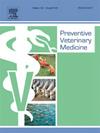停用氧化锌对丹麦养猪场抗菌剂使用的影响
IF 2.4
2区 农林科学
Q1 VETERINARY SCIENCES
引用次数: 0
摘要
在丹麦养猪业,由于环境问题,用于预防断奶仔猪与大肠杆菌相关的断奶后腹泻的氧化锌于2022年被禁止使用。本流行病学研究旨在评估停用氧化锌对丹麦农场断奶仔猪和育肥猪抗菌药物使用(AMU)的影响。利用国家数据库中2018年至2023年的农场和处方数据,我们将线性混合效应模型拟合到一个三层嵌套数据集,该数据集由兽医( = 146)监督的农场(n = 4020)的月平均标准化AMU(每猪日定义动物日剂量)组成。停用氧化锌对断奶仔猪的影响最为显著,停用氧化锌后的前5个月,AMU平均增加了~ 5 %,在停用氧化锌后的 个月,AMU平均增加了~ 17 %。在禁令实施前一年未使用氧化锌的农场的断奶仔猪也出现了长期影响,在禁令实施后5个月,AMU平均增加了~ 19% % >; ,尽管在禁令实施前AMU较低。农场之间的差异表明,缺乏氧化锌对断奶后腹泻患病率的影响受到个别农场管理做法的显著影响。由同一名兽医监督的农场之间AMU的随机差异比兽医之间的估计差异高10倍,这表明兽医开出的抗菌药物处方是针对每个农场的疾病状况的。估计的连续月份间抗菌素单位的自相关性表明,管理生产所需的恒定抗菌素数量与个别农场不变的管理做法有关。本文章由计算机程序翻译,如有差异,请以英文原文为准。
The effect of the discontinued use of zinc oxide on antimicrobial usage in Danish pig farms
In the Danish pig industry, zinc oxide, used for prevention of E. coli-related post-weaning diarrhoea in weaners, was banned in 2022 due to environmental concerns. This epidemiological study aimed to estimate the effect of the discontinued use of zinc oxide on antimicrobial usage (AMU) for weaners and finishers in Danish farms. Using farm and prescription data from 2018 to 2023 from national databases, we fitted a linear mixed-effect model to a three-level nested dataset, consisting of monthly average standardized AMU (Defined Animal Daily Doses per pig-day), on a farm (n = 4020), overseen by a veterinarian (n = 146). The most significant effect of the zinc oxide ban was seen for weaners, where AMU increased by ∼5 % on average in the first 5 months post-discontinuation, followed by a ∼17 % increase after > 5 months. A long-term effect was also seen for weaners on farms that did not use zinc oxide in the year preceding the ban, where AMU increased by ∼19 % on average > 5 months after the ban was enforced, although from a lower pre-ban AMU. The between-farm variation indicated that the effect of the absence of zinc oxide on the prevalence of post-weaning diarrhoea was significantly influenced by individual farm management practices. The random variation in AMU between farms overseen by the same veterinarian was ∼10 times higher than the estimated variation between veterinarians, indicating that antimicrobial prescriptions made by veterinarians are specific to the disease status in each farm. The estimated autocorrelation in AMU between consecutive months indicates that the constant amount of antimicrobials needed to manage the production is linked to non-varying management practices in individual farms.
求助全文
通过发布文献求助,成功后即可免费获取论文全文。
去求助
来源期刊

Preventive veterinary medicine
农林科学-兽医学
CiteScore
5.60
自引率
7.70%
发文量
184
审稿时长
3 months
期刊介绍:
Preventive Veterinary Medicine is one of the leading international resources for scientific reports on animal health programs and preventive veterinary medicine. The journal follows the guidelines for standardizing and strengthening the reporting of biomedical research which are available from the CONSORT, MOOSE, PRISMA, REFLECT, STARD, and STROBE statements. The journal focuses on:
Epidemiology of health events relevant to domestic and wild animals;
Economic impacts of epidemic and endemic animal and zoonotic diseases;
Latest methods and approaches in veterinary epidemiology;
Disease and infection control or eradication measures;
The "One Health" concept and the relationships between veterinary medicine, human health, animal-production systems, and the environment;
Development of new techniques in surveillance systems and diagnosis;
Evaluation and control of diseases in animal populations.
 求助内容:
求助内容: 应助结果提醒方式:
应助结果提醒方式:


